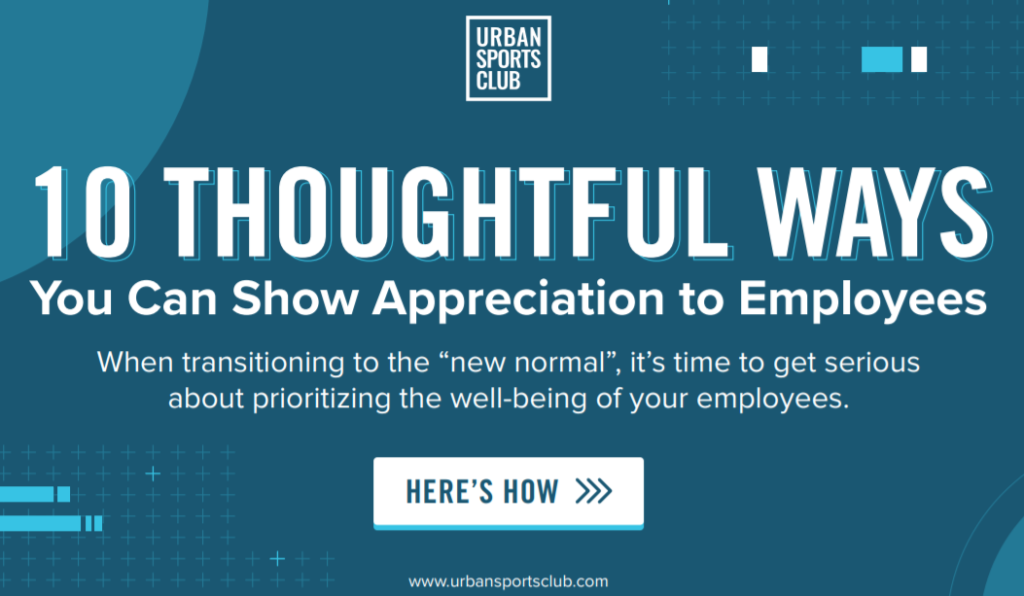As your company focuses on the transition back to “normal”, it’s important to remember and take into account the emotional health needs of employees. All businesses are experiencing similar challenges in terms of how to address employees’ safety and well-being while getting back into the routine of working in the office and focusing on their bottom line.
Each thing is important, so which should you concentrate on first? Your employees, of course! They’re your most important asset.
During these unprecedented times, your company has an opportunity to make a positive impression on your staff that will have long-lasting implications. People remember how you make them feel, which is why an attitude of gratitude towards employees goes a long way.
Wondering how to do this? In a recent Deloitte survey of 16,000 professionals, over half of them said they would be happy receiving a verbal “thank you” for their contributions, while 31% would appreciate a written “thank you”. These simple ways to show appreciation are certainly effective, but we’re here to discuss ways you can go even further to make sure employees know they are valued.
The following are 10 ways you can actively demonstrate to your team that you notice and appreciate their hard work.

1. Create a space for gratitude
Set aside a designated space in the office for written appreciation. Supply markers, butcher paper or post-it notes and encourage everyone to leave notes of gratitude for each other. At Piktochart, each employee decorates their own paper cup and attaches it to a thin rope on the wall. People fill the cups with messages of thanks and small gifts like unique snacks picked up while traveling. If you have some employees still working remotely, create a Slack page dedicated to the appreciation and post there often with prompts like “Name someone who has helped you with something at work this week.” Tools like Kazoo and Bonusly promote peer recognition and enable employees to accumulate points that can be exchanged for gift cards, cash or charity donations.
2. Allow flexible schedules
More than 10 percent of employees quit their jobs because of a poor work-life balance. Flexible scheduling makes a big difference, especially for parents who need to stay home with sick kids or want to be present for their children’s special milestones, employees with ongoing health issues, caretakers, etc. This can be implemented in different ways. For example, you might be open to employees taking a midday break to go to the gym, which boosts productivity and encourages trust. Or you might go as far as letting employees decide when and where they work.
3. Invest in education
Investing in the professional development of your team shows that you care about them and what they contribute to the company. Send individuals to a seminar or pay for an educational online course of interest to them. You can also dedicate one day a week or month to learning only – for example, reading, listening to podcasts and watching webinars. You can then encourage employees to share what they’ve learned afterward.
4. Let your employees shine
Find new ways to give acknowledge good work. Make it a point to mention employees’ projects in meetings or create an internal newsletter highlighting their achievements. Reinvent the “Employee of the month” program by allowing employees to nominate co-workers for different categories like the Value Victor (based on your company values), the Fresh New Skills Award for an employee who underwent professional development, or shake things up with the Best New Mistake – acknowledging someone who took a risk, made a mistake, and the company learned from it. Remember you can go beyond verbal recognition. Think custom-designed certificates, trophies, t-shirts, a coveted parking spot, or perhaps, as gaming company Scopely offers, a custom oil portrait of employees.
5. Surprise with gift cards to a local business
Randomly hand out gift cards to local businesses to show appreciation. A yummy sandwich or latte tastes that much better when it’s paid for by the company. Treat your team and support local businesses at the same time.
6. Bring self-care to the office
Organize on-site chair massages, meditation sessions or a live exercise class at the office. This makes it both convenient for everyone to focus on their well-being at work and helps them bond with teammates.
7. Assign special projects.
Is money tight? Not a problem. A McKinsey Quarterly survey found that non-financial incentives like attention from leaders and opportunities to lead projects were stronger motivators at work than performance-based cash bonuses, pay increases or stock options. You might focus on individuals or plan a Hackathon that lets teams create something over a short period of time that will be launched as a beta project. Enabling employees to work on special projects beyond their regular responsibilities demonstrates confidence and fosters growth.
8. Give impromptu time off
Dedicated teams savor well-deserved breaks. You might send an email that says, “You’ve worked hard this week. Don’t come in until noon tomorrow.” Spontaneous late arrival or early departure days are hard to forget.
9. Introduce employee benefits focused on health
Show your team that their well-being is a company priority by adding new perks specifically focusing on health. For example, give a stipend for workspace upgrades like ergonomic chairs, computer stands, or plants which provide physical and mental benefits. Or, empower each employee with a flexible fitness membership where they can choose the activities they enjoy to stay healthy.
10. Start a work suggestion program
Ask employees how they would improve the current way of working. This will get them involved in shaping company culture while reinforcing your core values. Whether you have a portion of the team working from home or you’ve got everyone coming back to the office at the same time, listening to your team’s ideas and creating a solid plan together is a smart way to navigate uncharted territory.
Also, feel free to have a look at our tips about how to strengthen your employer brand when employees need it the most and how to build a successful employee health and wellness program.


